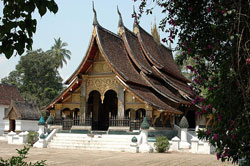Wat Xieng Thong is the temple highlight of Luang Prabang. It was built by King Saisetthathirat in 1560 and is located on a peninsula, in between the Mekong and Khan rivers. Temple structures are decorated in various ways. Some with gilded stucco's and doorways. The main sim has a marvellous 'tree of life' mosaic pattern on an outer wall.
A smaller temple is decorated with mosaics, depicting mostly daily life activities.

History
Wat Xieng Thong is very old, built around 1560 by King Setthathirat, a patron of Buddhism, who ruled Laos from 1548 to 1571. The temple is located in a beautiful garden on the bank of the Mekong River where the Nam Khan, a smaller river runs into it.
There are many legends about the place where the Nam Khan enters the Mekong. It is believed to be the site where the two hermits, who founded Luang Prabang, placed the boundary stone for the new settlement. Another story tells about a betel merchant with the name of Chanthapanit who built a palace on this site, making himself the first king of the new capital. It has been said that he was the first founder of Wat Xieng Thong.The union of the Nam Khan with the Mekong is also said to be the home of two nagas (water spirits in the form of large snakes), the guardians of the river. A shrine to the nagas existed at the site until recently.
Until 1975, when the Communist Party gained control over Laos, Wat Xieng Thong was a royal temple, supported by the royal family. It was the place where the former kings of Laos were crowned and granted their power. When we look at the past history of Wat Xieng Thong, it and the other major temples were as Betty Gosling writes, "sites of rituals in which Buddhist, pre-Buddhist, and royal traditions met, overlapped, and meshed." (p. 35)
We do not know what the sixteenth century temple looked like, one of the earliest photographs of the sim or chapel is shown below. It is a small building with a low sweeping roof of three tiers. The supporting columns are square and white washed. A broad staircase leads into the interior. At the sides are two pillars holding bronze lotus buds.
During the 1960s Wat Xieng Thong was completely remodeled and redecorated, becoming the splendid temple we see today. The roof was repaired. The entrance was gilded. Both the interior and the exterior walls were covered with black, glossy lacquer and decorated with figures and symbols in gold leaf. On the back wall a large flame tree, a tree of life, was set in colored glass mosaics.
What To See
Wat Xieng Thong is note for its large sweeping roof with its many decorations. Fresh whitewash covers the stairs, the pillars supporting the lotus buds, and the base of the building. At the bhe back of Wat Xieng Thong is the famous "tree of life mosaic" in colored glass on a dark red background. This is one of the best known images in modern Laos. The mosaic was crafted in 1960 by the Lao craftsmen.
Large carved and gilded door man the entrances to the main chapel. On the left hand side ogf each door is a large figure in gold leaf on black lacquer. In the interior of the temple, small figures in gold leaf are illustrated on walls, giving a picture of the daily activities of a Lao village. Visitors can see people playing, winnowing rice, cooking, and near the top, paying their respects to the Buddha at a temple.
A large image of the Buddha sits on a platform in the hall, surrounded by smaller images, candles, and offerings.
One can also find within the temple compound smaller chapels, three of which stands out from the rest. There's a chapel with caved walls with gilt on a pink background. The carving shows worshipers and Buddha images in a pastoral setting with trees, plants, and animals.
Another one is a carved and gilded building that houses the cremation vehicles and urns of the recent Lao monarchs. The carvings show scenes from the Ramayana. One will be able to see the cremation chariot of the Lao king with large naga heads in front. In the back is the the cremation urn, which holds the body in a curled up position is deeply carved and gilded.
Another small chapel has dark red exterior walls with colored glass mosaics. Visitors will find a tiered roof with upward figures at the peaks. Here the mosaics show a shrine on a river with a large boat drifting by.
Source
Dr. Constance Wilson, Department of History, Northern Illinois University.



